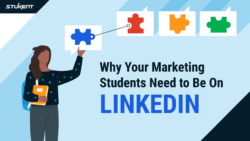As audiences grow increasingly digital, keeping abreast of the digital marketing and social media industries can be challenging. Trends, strategies, and cultural expectations in online spaces can change overnight, leaving academic curricula woefully out-of-date. To help educators stay current with ever-evolving industries, Stukent hosts digital summits every spring, summer, and fall with industry leaders and academic experts. These summits bring fresh perspectives, insights, and strategies to the classroom, giving educators tools to prepare students for today’s marketing industry.
The Spring 2022 Stukent Digital Summit featured experts from HubSpot, Adobe, and academic institutions all over the United States. In four informative sessions, presenters covered online communities, SEO, social media wellness, and professional development and leadership.
Read on to learn more about the Spring 2022 Stukent Digital Summit, or visit the webinar homepage to view the presentations!
Community Building 101: Christina Garnett, HubSpot
A robust community can champion a brand, build market share, provide product insights, and more. But how do brands build communities that become inviting, engaging spaces for their consumers? Christina Garnett, community manager at HubSpot, joined the Spring Stukent Digital Summit to explain how to build an engaging online community.
“If communication is one-sided,” Garnett says, “then the relationship is one-sided. … Community is more of a web — there’s going to be more connective tissue there, and more opportunities to [make customers] feel like [they] are a part of something bigger.”
Within the framework of a community, brands should make users feel like the conversation is a two-way street. Users in a niche group are often knowledgeable about the products and services in their industry, which means marketers can learn a lot by listening to their community. These conversations can tell marketers what consumers like, what topics they enjoy, and what motivates them to buy. Additionally, communities allow consumers to connect over their shared enjoyment of a product or service.
In Stukent’s “Essentials of Social Media Marketing” courseware, Michelle Charello writes, “Social media provides a platform for everyday customers to interact directly with brands in a way that was never achievable before. Consumers can share their positive or negative experiences with products or brands with a wide audience,” which only makes the power of a connected, engaged online community more potent.
So, what steps might a brand take to build an active, engaged community? Garnett recommends using Community Canvas, a tool that helps brands and community managers define their vision. This tool asks nine questions to create focused, customer-centric spaces.
Above all, community builders should strive to make their customers feel special. “When you forget about your customers, you will take them for granted,” Garnett says. “If you focus on people, the metrics will come. [But] if you focus on the metrics, people will start to look like numbers to you.”
Garnett suggests that community builders make a concerted effort to welcome new people to their community, thank their brand champions, ensure that detractors feel heard, and help the community’s “lurkers” — or users who don’t participate in conversations frequently — feel like they are in a safe space.
With the right investment, online communities can become powerful allies for brands and businesses.
To view the “Community Building 101” presentation, please visit the webinar homepage. Or, to find more information about Michelle Charello’s “Essentials of Social Media Marketing” courseware or Stukent’s Mimic Social simulation, please visit our social media product page.
Tools for Benchmarking and Measuring Inbound Marketing Performance: Steve Wiideman
When it comes to search engine optimization, planning and measuring your efforts is key to success. That’s why Steve Wiideman, coauthor of Stukent’s “SEO: Strategy & Skills” courseware, joined the Spring Stukent Digital Summit to discuss his insights on how to grow a website’s inbound marketing performance.
“When a business engages in SEO,” Wiideman and Cowley write in the courseware, “we are enhancing the content with the desired results being a place physically higher on a search results page where the right searchers (those in the target market) will be more likely to see the business and click the website,” resulting in increased sales or leads. In today’s e-commerce marketplace, ranking a page in Google is key to success.
Wiideman highlighted three steps for getting a webpage ranked in Google: content, off-page, and user behavior. “This [process] is a marathon, not a sprint,” Wiideman says, because it can take months — and sometimes years — to get non-brand pages ranked at the top of page one.
Content is an essential element of SEO. “From a content standpoint, if we’ve addressed everything is a user is searching for, we’ve solved [the first] problem of three,” says Wiideman. Content includes optimizing elements such as the page URL, title, headings, keyword density, internal links, anchor text, and more.
Secondly, off-page links are critical to SEO success. Content is scored by the quality of the links and the pages your content is linked to; in other words, “The more high-quality links you get to your website — and to your specific pages — the higher the search engines are going to rank you in the results,” says Wiideman.
Next, user behavior is key to elevating a website’s ranking. By influencing a user’s search behavior signals, SEO marketers can indicate to a search engine that their page is the best result for a particular keyword. “When there are ten listings in the results,” Wiideman says, “yours shouldn’t be the one with just a blue link and black text below it — yours should be the one with all those great other features around it, such as FAQs, video and image thumbnails, and star ratings. Your titles will invoke calls to action … it will include a value proposition so that users want to click on your listing.”
Furthermore, Wiideman detailed the types of metrics that marketers can use to set benchmarks for SEO success. “The way we hold our team accountable [for] the success of our SEO is by looking back at the past month and saying, ‘Did we improve the quality and helpfulness of our content, compared to the other results that appear for the words we want to appear for?’”
To view Wiideman’s full presentation, please visit the webinar homepage. Or, to learn more information about Wiideman and Cowley’s “SEO: Strategies & Skills” courseware and simulations, please visit our website.
#SocialMediaWellness: Breanne Mertz, Ashley Hass, and Kelley Cours Anderson
Over the last decade, social media has grown exponentially. Social media platforms now reach more than 4.5 billion users in the world. The average user now spends four hours a day on devices and roughly two hours and 24 minutes on social media. Over a lifetime, a user will spend an average of 5.7 years consuming social media. Yet studies have linked social media use to depression, anxiety, body dissatisfaction, memory loss, disrupted sleep, and poor academic performance.
With so many risks involved, how can educators help students manage their own social media usage and lead healthier lives and careers — particularly when those students may become social media professionals themselves?
That’s the question that Breanna Mertz, Ashley Hass, and Kelley Cours Anderson set out to study in their recent academic paper, “#SocialMediaWellness: Exploring a Research Agenda for Healthy Social Media Consumption.” In their research, they explored three main themes of social media wellness and their impact on users, including:
1) A desire for ideal priorities,
2) Educating impressionable youth, and
3) Rejecting social media for mental health and mindfulness.
“As educators,” says Kelley Cours Anderson, assistant professor of Marketing at the College of Charleston, “we have an ethical imperative to educate our students to be knowledgeable consumers [of social media] … and understand the tensions within our marketplace.”
Young people are particularly vulnerable to influence: “It’s not atypical for a student to spend four to eight hours [a day] on social media,” says Cours Anderson. Educators should encourage students — especially those who work with social media — to set healthy boundaries for screen time. Social media managers face challenges of burnout and high turnover. Policymakers on both the state and federal levels should implement policies and trainings that help young people develop healthy social media habits.
Social media platforms are trying to support their users, too. In the “Essentials of Social Media Marketing” courseware, Michelle Charello writes, “To help Snapchatters cope with mental health … Snapchat launched a feature called ‘Here for You.’ This feature produces resources from experts and proactive, in-app support … for mental health or emotional [crises].” Facebook has also implemented changes in its algorithm to boost users’ mental health and sense of well-being.
Even with these changes, there’s no substitute for instilling or developing boundaries for social media usage. Students who develop healthy habits will be happier and healthier in the long term, regardless of their future fields.
To view the complete “SocialMediaWellness: Exploring a Research Agenda for Healthy Social Media Consumption” presentation, please visit the webinar homepage. For more information about Michelle Charello’s “Essentials of Social Media Marketing” courseware or Stukent’s Mimic Social simulation, please visit our social media product page.
Leaders Within: Skills for Professional Development: Katie Meloche, Adobe
Good leadership takes many forms, especially in the classroom. In an inspirational presentation, Adobe’s Katie Meloche spoke about the five types of leadership educators can cultivate in their professional and personal relationships: visionary leadership, intuitive leadership, collaborative leadership, servant leadership, and the leader within.
The leader in the front is a person who “is waving the flag and has the vision, and is leading the charge toward a common goal,” says Meloche. These leaders hold the organizational vision, foster connection, and inspire their teams; moreover, they are responsible for keeping their team aligned with the organization’s goals. The “leader in front” is the quintessential leadership style; this is the teacher at the head of the class, inspiring their students and helping them to build new skill sets.
The leader beside, or the collaborative leader, is a member of a “consciously designed partnership,” says Meloche, where team members “intentionally partner together … to drive [desired] outcomes.” These leadership roles can foster unexpected results, allowing team members to “shine their brightest.”
The leader behind, or the servant leader, is the one who is “helping people … to feel empowered, to make decisions for themselves, and helping them to turn on that lightbulb,” says Meloche. “We’re helping them get that understanding and that context for themselves.” Many educators adopt the “leader behind” role, fostering good decision-making skills in students and encouraging them to discover new insights.
A leader in the field, or the intuitive leader, is in tune with intuition, imagination, creativity, and insight. This leader takes both internal and external factors “into consideration, [including] how [people] are engaging with each other, how they are working together, and offering a wise, sage perspective [on the project],” says Meloche. This form of leadership is more vulnerable than other types.
Finally, the leader within is at the model’s center and is the most foundational piece. “This requires you to align to personal values and goals,” says Meloche. “If I’m living my truest purpose … bringing my energy out into this world, I have to be grounded in who I am.” This particular form of leadership extrapolates to all other forms of leadership, providing a platform for self-acceptance and self-authority. Meloche’s model helps educators determine where they’re at in the leadership spectrum, then strengthen their commitment to the students they teach. To watch Meloche’s complete “Leaders Within: Skills for Professional Development” presentation, please visit the webinar homepage.
During the Spring Stukent Digital Summit, presenters brought fresh ideas, new research, and time-tested leadership techniques to the floor. So, whether you’re looking to keep up with the industry’s latest SEO trends, help your students build incredible online communities, or upgrade your leadership skills, Stukent is here to help you stay current!
The Spring Stukent Digital Summit was a one-day event held on April 1, 2022. This Stukent webinar focused on actionable tips and tools for marketing and social media educators. You can access the entire webinar from the event homepage.
To learn more about Stukent’s courseware and simulations or get FREE instructor access to our products, please visit our website.






